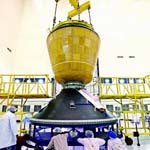
ISRO to Test Crew Module for Sending Man to Space
SRIHARIKOTA: Space travel has been one of mankind’s greatest dreams. On 12 April 1961 Russian cosmonaut Yuri Gagarin became the first human in space when he orbited the Earth once during a 108 minute flight. The scientists at the Satish Dhawan Space Center in Sriharikota as busy integrating a a brown bucket-like structure with a black lid mounted on a pedestal, hoping that one day, an improved version of this module will be able carry human beings into space.

ISRO working on sending man to space.
After the successful launch of the Mars Orbiter Mission in November 2013, ISRO is slowly taking steps to send man to space. The experimental flight of the GSLV-Mark III all set to carry this ‘crew module’ as the payload in the second week of December is being prepared. Though the dream of a manned mission is still a decade away, a full-fledged flight of the GSLV-MIII is just a couple of years away.
The GSLV-MIII is the biggest rocket ever made by ISRO and can carry a payload of upto four tonnes, which has become a necessity. Scientist have developed a cryogenic engine at ISRO’s Mahendragiri facility. In the experimental flight called the LVM3-X/CARE mission, the cryogenic engine C25 will not be used.
ISRO’s first space recovery experiment (SRE-1) module launched by a PSLV in January 2007 weighed just 555kg, and it was not a crew module. It re-entered atmosphere and was successfully collected from the Bay of Bengal.

ISRO’s CARE MODULE
The unmanned module to be used in Crew Module Atmospheric Re-entry Experiment (CARE) is to test the ability of the module to re-enter the Earth’s atmosphere with thermal resistance, parachute deployment in cluster formation, aero braking system and apex cover separation procedures.
The Crew Module has been tested by airdropping from IAF choppers and the test flight will allow them to actually map it’s trajectory and the thermo resistance capacity of the exterior. The module will be packed with 3 sets of parachutes, including one with a diameter of 31 meters, making it to be the biggest ever made in the country. Experts quoted that the future manned modules will be similar with a separate chamber for life support.
Picture source: isro.org








